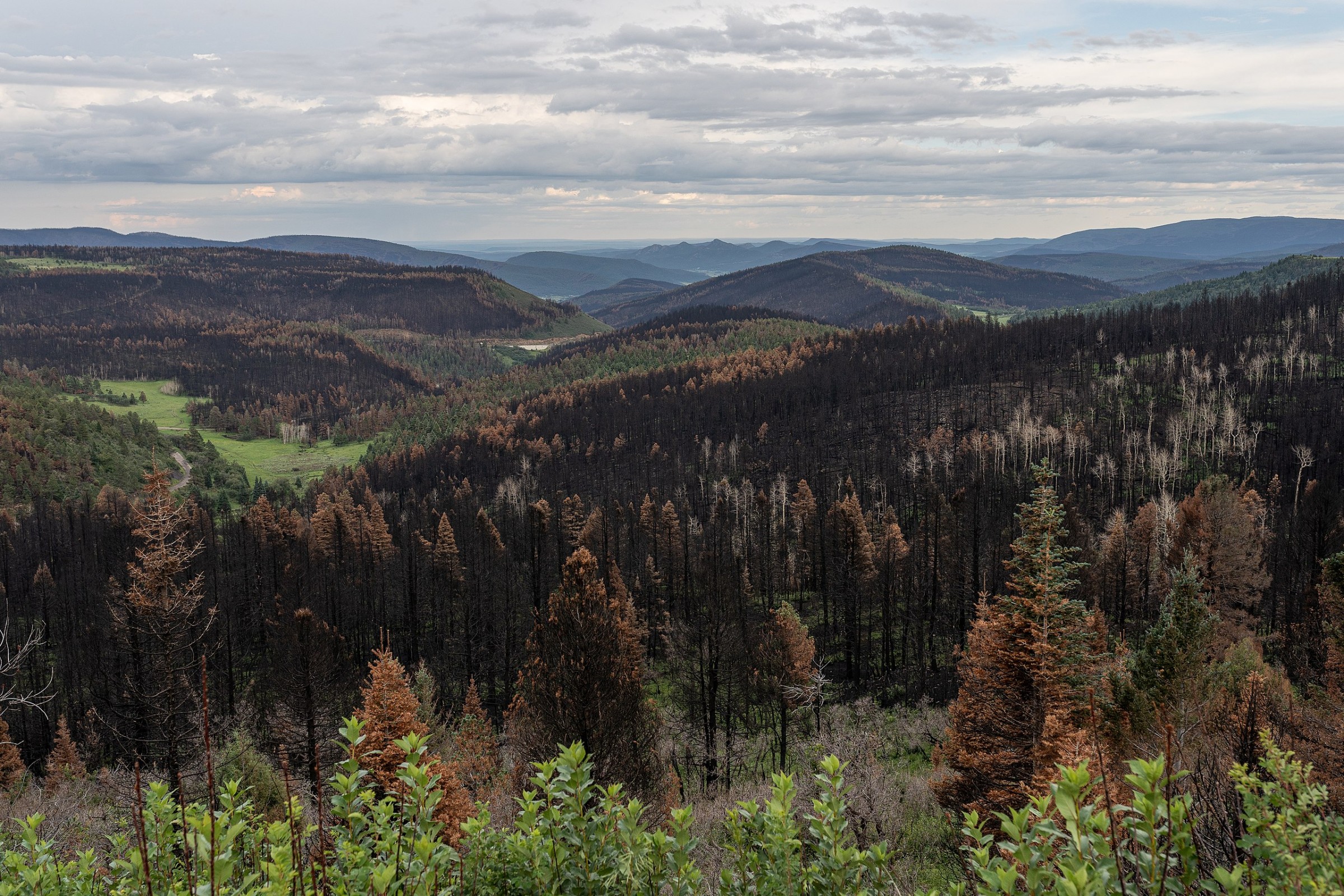The town of Las Vegas is eligible for up to $140 million for drinking water treatment facilities.

Burn scars from the Hermits Peak/Calf Canyon fire, which burned more than 341,000 acres in New Mexico’s Santa Fe National Forest in 2022. Photo courtesy of Matthew Kowal under a Creative Commons license
By Brett Walton, Circle of Blue – January 12, 2023
A New Mexico town that is intimately aware of the water supply risks from a drying climate could receive up to $140 million to rebuild its water system after the largest wildfire in state history tore through its watershed last year.
Besides being a lifeline, the funds also illustrate the financial and ecological vulnerability of small, high-poverty communities in the face of extreme weather.
In the fiscal year 2023 budget that President Joe Biden signed just before the new year, Congress set aside $1.45 billion for post-fire recovery in New Mexico. That’s in addition to $2.5 billion that lawmakers had already directed to the state, bringing the total amount of federal aid after the Hermit’s Peak/Calf Canyon fire to nearly $4 billion. Included in the year-end appropriations package was a line item of particular significance: $140 million for water treatment systems for communities around the fire’s burn scar. That includes the town of Las Vegas, located just 12 miles from where the fire started.
“That assurance that we’ll have high-quality water is tremendous,” Maria Gilvarry, the town utilities director, told Circle of Blue.
High-quality water is what Las Vegas, home to 13,000 people, does not have right now. The town’s main water source, the Gallinas River, is surrounded by scars from the Hermit’s Peak/Calf Canyon fire. The fire ignited in April, after a U.S. Forest Service prescribed burn grew out of control. The fire, the largest on record in the state, ended up burning 341,735 acres of public and private land.
Once a clear stream, the Gallinas River today is laden with sediment and suspended solids due to ash and soil erosion. That’s a serious problem for the water treatment operators in Las Vegas. The fire did not destroy the treatment system. Instead, it rendered the existing facilities inadequate.
“Our system cannot treat the water we have now,” explained Gilvarry, who has led the utility department for six years. Before the fire, water from the Gallinas River registered about 20 or 30 NTU, a measurement of the water’s murkiness, or turbidity. Now readings a hundred times higher are not uncommon. The current treatment system struggles under those conditions.
Lawmakers recognized those circumstances when lobbying their colleagues for aid.
“I remain committed to restoring the health of our forests and watersheds and making sure that New Mexico families and communities are made whole again,” said Sen. Martin Heinrich, who helped secure the funding for his state.
Gilvarry, however, does not foresee water quality improvement any time soon. The fire killed millions of trees in the Sangre de Cristo Mountains, she said. The soil is primed to move downstream in a rainstorm.
Until a new treatment system is in place, the utility department is making do with temporary equipment to remove sediment. It is also re-calibrating the chemicals to purify drinking water so that treatment process is more effective.
Gilvarry said federal aid is an undeniable blessing for a predominantly Latino city where median household income is just $34,335 — about half the national figure. The poverty rate is above 30 percent.
Federal aid is the only way the water treatment project could move forward so quickly, Gilvarry said. “Not on our own dime. This is a low-income community.”
Quickly does not mean immediately. Gilvarry reckoned that a new system might take five or six years to plan, design, and build. FEMA will be managing the funds. To diversify the water supply, Gilvarry is also investigating a water recycling facility that would return treated wastewater to the town’s reservoir.
In the meantime, Gilvarry is preparing for the summer monsoon season, when heavy afternoon rains could cause the river’s sediment levels to spike. Residents need to continue their admirable conservation efforts, she said.
One option for meeting next summer’s demand amid a turbid river is to purchase water from elsewhere to have in storage. If there was one lesson Gilvarry learned last year, it was the benefit of alternative water supplies. “It was a wake-up call,” she said.
An earlier version of this article incorrectly stated that Las Vegas will receive $140 million from the appropriations bill. Las Vegas is eligible to receive up to that amount, but the funding is not specific to one community.
Brett writes about agriculture, energy, infrastructure, and the politics and economics of water in the United States. He also writes the Federal Water Tap, Circle of Blue’s weekly digest of U.S. government water news. He is the winner of two Society of Environmental Journalists reporting awards, one of the top honors in American environmental journalism: first place for explanatory reporting for a series on septic system pollution in the United States(2016) and third place for beat reporting in a small market (2014). He received the Sierra Club’s Distinguished Service Award in 2018. Brett lives in Seattle, where he hikes the mountains and bakes pies. Contact Brett Walton




